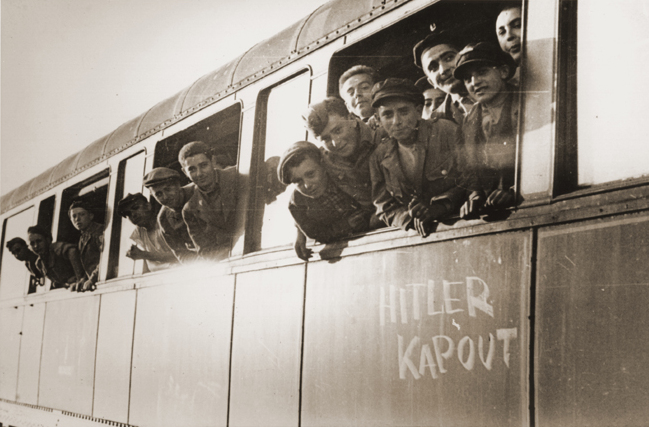English: Jewish youth liberated at Buchenwald lean out the windows of a train, as it pulls away from the station. The train, which has been marked with the phrase "Hitler kaput" [Hitler is finished], will transport the children to an OSE (
Œuvre de secours aux enfants) home in Ecouis, France.
Romek Wajsman (now Robert Waisman) is the son of Rywka (Gil) and Chiel Wajsman. He was born on February 2, 1930 in Skarzysko, Poland, where his father worked as a tailor. Romek had five older siblings, Chaim, Mottel, Moishe, Abram and Lea. The Wajsman family was forced into the local ghetto in the fall of 1941. Romek's older brothers were sent to work in the HASAG factory camp in Skarzysko. Chaim obtained information about the planned liquidation of the Skarzysko ghetto shortly before it was to occur. In the early morning hours of the appointed day, Chaim entered the ghetto and smuggled Romek out in the back of a truck. Chaim managed to obtain a permit for Romek to work with his brothers at the HASAG plant, marking aircraft shells with the factory's initials. With the advance of the Red Army in the summer of 1944, the HASAG camp was closed, and Romek was sent to dig anti-tank ditches in Przedborz. Subsequently, he was transfered to the HASAG camp in Czestochowa. He remained there for several months, before being sent to Buchenwald. Romek was liberated in Buchenwald on April 11, 1945. Shortly afterwards, representatives of the OSE (Oeuvre de Secours aux Enfants) came to the camp and arranged for the transport of 430 Jewish children, Romek among them, to an OSE children's home in Ecouis, France. Romek was transferred from Ecouis to the OSE home at Le Vesinet, near Paris. In 1948 he and twenty other OSE children immigrated to Canada with the help of the Canadian Jewish Congress. Romek and his sister, Lea, were the only members of the family to survive the war.
The Buchenwald children were a group of approximately 1000 Jewish child survivors found by American troops when they liberated the Buchenwald concentration camp on April 11, 1945. Most of the children were originally from Poland, though others came from Hungary, Slovenia and Ruthenia. Unsure of what to do with the child survivors, American army chaplains, Rabbi Herschel Schacter and Rabbi Robert Marcus, contacted the offices of the OSE (Oeuvre de Secours aux Enfants) Jewish children's relief organization in Geneva. They arranged to send 427 of the children to France, 280 to Switzerland and 250 to England. [Vivette Samuel reverses the figures for England and Switzerland in her monograph, "Sauver les Enfants."] On June 2, 1945 OSE representatives arrived in Buchenwald and together with Rabbi Marcus escorted the transport of children to France. Rabbi Schacter accompanied the second transport to Switzerland. Because of the difficulty in finding clothing for the children, the boys were clad in Hitler Youth uniforms. This created a problem, for when the train crossed into France, it was greeted by an angry populace who assumed the train was carrying Nazi youth. Thereafter the words "KZ Buchenwald orphans" were painted on the outside of the train to avoid confusion. On June 6, 1945 the French transport arrived at the Andelys station and the orphans were taken to a children's home in Ecouis (Eure). The home had been set up to accommodate young children, but in fact only 30 of the boys were below the age of 13. This was only one of the many problems faced by the OSE personnel, who were not prepared to handle a large group of demanding, rebellious teenagers who were full of anger for what they had experienced. At Ecouis the boys were given medical care, counseling and schooling until more permanent accommodations could be found. Most of the children remained only four to eight weeks at Ecouis before being moved elsewhere, and the home was closed in August 1945. Among the first to leave were a group of 173 children who had family in Palestine. They were given immigration certificates and departed from Marseilles in July aboard the British vessel, the RMS Mataroa. The remaining boys at Ecouis were soon transferred to other residences and homes. Some of the older ones were sent to the Foyer d'Etudiants located on the rue Rollin in Paris, where they boarded while attending vocational training courses or working at jobs in the city. Others were sent to the Chateau de Boucicaut home in Fontenay-aux-Roses (Hauts-de-Seine). Many of the boys came from religiously observant homes. Since the OSE could not obtain kosher food for everyone, they divided the children into religious and non-religious groups. Dr. Charly Merzbach offered OSE the use of his estate, the Chateau d'Ambloy (Loir-et-Cher) for the summer, and between 90 and 100 boys chose to go there in order to receive kosher food and live in a religious environment. In October 1945 the children and staff of Ambloy were relocated to the Chateau de Vaucelles in Taverny (Val d'Oise). About 50 of the non-religious boys were taken to the Villa Concordiale in Le Vesinet (Yvelines) near Paris that housed an equal number of French Jewish orphans. In the summer they went to the Foyer de Champigny in Champigny-sur-Marne (Val-de-Marne). In all the homes attended by the Buchenwald children vocational training as well as regular classroom instruction was offered. At the same time OSE social workers made every effort to locate surviving relatives, succeeding in about half the cases. By the end of 1948 all of the Buchenwald children who had come to France had left the OSE fold and begun new lives for themselves. [Sources: Hemmendinger, Judith and Krell, Robert. "The Children of Buchenwald." Gefen Publishers, 2000; Grobman, Alex. "Rekindling the Flame." Wayne State University Press, 1993; Hazan, Katy, "Chronologie de l'histoire de l'OSE L'action de l'OSE apres la guerre." (31 December 2002).]




